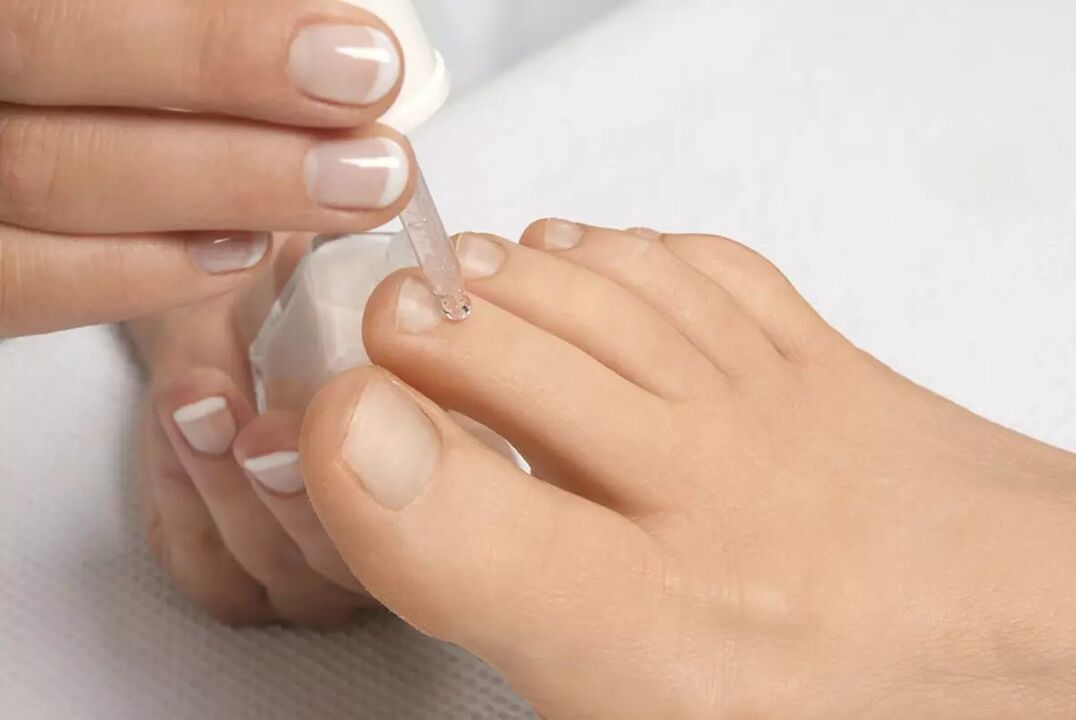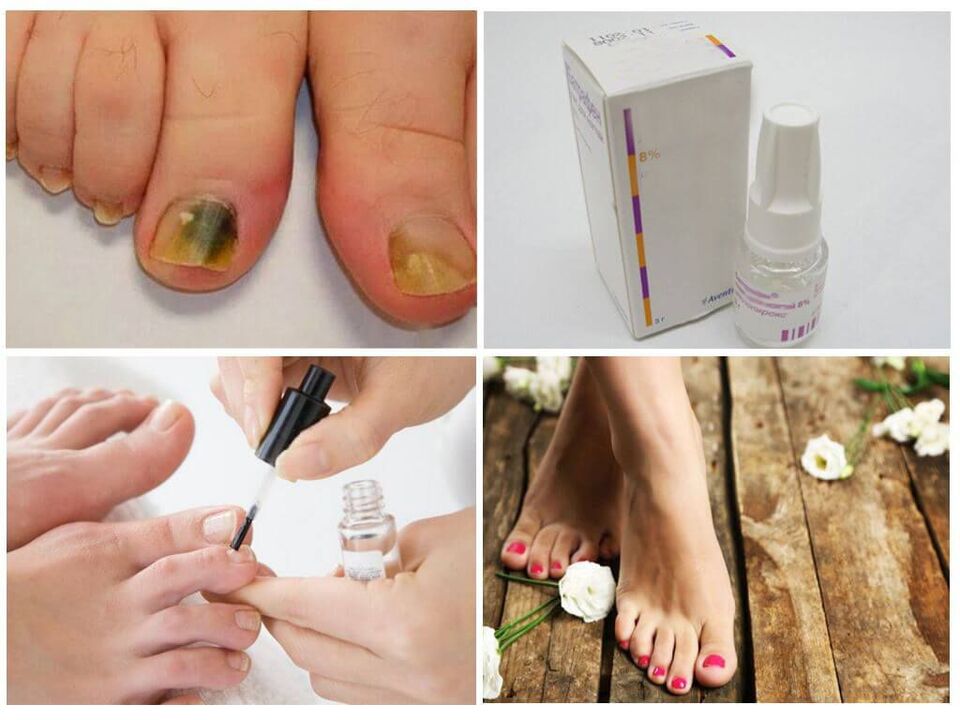Healthy and beautiful nails are an integral part of the image of a well-groomed person. During a greeting, the interlocutor pays attention to the hands when they are shaking and unconsciously evaluates their condition. That is why it is recommended to use nail polish against nail fungus as a preventive and therapeutic agent.
The principle of action of antifungal paints

The treatment lasts for many days after application to the nail.
Depending on the severity of the disease and the location of the fungal infection, doctors recommend different means and techniques that, in each specific case, will cure the fungus in the shortest possible time. At the initial stage of the infection, a good reaction was noted after the use of a special antifungal paint. The active components of the composition penetrate deep into the nail plate and can even kill fungal spores.
Once applied, the nail plate softens, thus improving the penetration of the treatment. After drying, the concentration of the antifungal drug in the affected tissues increases by 20% and persists for seven days. The maximum concentration of the active ingredient is reached on the seventh day of using the paint on the hands and on the fourteenth day on the feet.
Manufacturers of antifungal paints produce their products under different names, but the principle of operation of each of them is identical. Therapeutic antifungal varnishes are actively used to eliminate onychomycosis and prevent relapse of the disease. To prevent fungal infections, such agents are also used very effectively.
Fungus nail polish can have an alcohol or oil base. Regardless of consistency, they are equally effective at inhibiting the spread of fungal infections. The main thing is to find out the type of pathogen in advance in order to correctly select the active component and its concentration. Only in this case the use of paint will give the expected result.
The liquid consistency allows the active components of the nail polish to penetrate into every microcrack of the treated surface for a more effective effect even on the deeper layers of the nail plate. The active components of the paint work most effectively in the initial stage of development of a fungal infection. They destroy not only fungal cells, but also their spores. Once dry, the composition covers the nail with an imperceptible film, which prevents oxygen from penetrating the remaining spores, making it impossible for them to reproduce further.
When caring for nails affected by fungus, it is necessary to use strictly individual tools, which must be disinfected after each use. Otherwise, you can provoke reinfection.
When treating nail fungus, it should be borne in mind that toenails can accumulate several times more medicinal substances than fingernails. It is also undesirable to use antifungal paints from different companies at the same time, as this leads to a decrease in the antifungal effect and a delay in the treatment process.
Advantages and disadvantages
Let's consider all the positive and negative aspects of using nail polish against nail fungus. The treatment procedure itself requires preliminary preparation of the nails. Note that most often the fungus is diagnosed on the feet. This is due to the fact that when wearing dirty, poor quality or uncomfortable shoes, the feet are often exposed to a humid and hot environment, which in itself is conducive to the development of fungi.
Some of the most important disadvantages of antifungal varnish are the high price and the long preparation of the feet before using the product. Cheap drugs of this type may indicate a counterfeit, so you should not buy them.
During treatment, it is necessary to completely abandon foot care procedures (pedicure, varnish, use of lotions and creams). These measures can result in increased growth of the fungus and aggravation of the inflammatory process.
Positive aspects include the effectiveness of the product in the initial stage of development of fungal diseases and ease of application. An important advantage of this form of antifungal drug is not only the ease of application, but also the formation of a durable film that "fixes" the active ingredient in the affected area and prevents it from washing away.
We can also add a whole list of positive aspects of using it:
- fixes quickly on the nail;
- local effect without additional drugs;
- minimal toxicity;
- it is for free sale;
- easy to use;
- has a preventive effect;
- acts sparingly.
How to apply medicinal paints correctly
Before using any nail polish for toenail fungus, you need to prepare the infected surface. To do this you need to wash your feet, preferably using laundry soap, and dry your skin with a natural cloth. If necessary, you can steam your nails in water with the addition of tincture of celandine or propolis (for further disinfection).
Next, you need to disinfect the surface of the nails and, using a special file supplied with the varnish, clean the affected surface of the nail and shorten its length. Only then can the paint be applied.
For those who are afraid to clean the nail plate themselves or do not want to remove it, there is a simpler way to prepare the nail - a hygienic bath with a solution of soap and soda.
Once preparation of the infected nail is complete, an antifungal agent is applied. Experts recommend carrying out the procedures at least once every 7 days. Before reapplying the paint it is necessary to remove the previous treatment layer using a common solvent. Processing is carried out strictly according to the instructions that come with the kit, since each drug has its own nuances when used.
Which nail polish is better for nail fungus: a review of effective remedies
Very often patients ask their doctor which paint against fungus is considered the most effective. It is impossible to recommend the best paint for toenail fungus due to the individual characteristics of each person's body, the degree of infection and the type of fungus causing it. Therefore, the same drug in different cases can manifest itself in completely different ways. Below we present a list of the most effective drugs against nail fungus, but they should still be selected individually.
Paint with the active ingredient amorolfine
This is one of the cheapest drugs in the line of antifungal paints. Its price depends on the place of purchase. The therapeutic effect of this varnish appears only at the initial stage of fungal development, when the nail has not lost its normal structure and the nail plate is not affected by more than a third. Otherwise its use will be useless. During application you may feel a slight burning sensation in the areas to be treated.
Paint with the active ingredient amorolfine hydrochloride
The same colorless varnish, which is applied in a thin layer after removing the upper keratinized layer from the nail plate. The paint set includes disposable nail files (12 pieces), applicators, cleaning pads and spatulas.
When used correctly, the drug works by inhibiting the synthesis of ergosterol. As a result of such a failure, processes are started that have a destructive effect on the vital activity of fungal cells.
The composition of the varnish quickly penetrates the treated nail plate and after 24 hours reaches the maximum therapeutic effect. The active ingredient of the drug acts for 10 days after the first use of the paint. The paint works best in the early stages of the disease. After applying the drug, using a spatula, you need to wait for the paint to be completely absorbed. This only takes a few minutes. Next, the spatula is cleaned with an alcohol wipe (swab) and folded back into place.
Paint with the active ingredient amorolfine hydrochloride - 64. 0 mg
This toenail fungus paint works well even in advanced cases of the disease. But it won't be able to satisfy you with its prices. To undergo paint treatment, you will have to spend a lot of money. The active ingredient amorolfine is effective in the process of destroying yeasts and molds. If you strictly follow the treatment regimen, the unpleasant symptoms will quickly disappear and the fungi will be completely destroyed.
This drug is often recommended as the most effective paint against nail fungus. At the same time it has a pleasant smell, relieves inflammation, which leads to a reduction in itching and peeling. The course of treatment will be long and in advanced cases it can last up to 4-6 months or even up to a year.
The paint tube comes with all the necessary accessories: disinfectant wipes, applicators and disposable nail files. The affected area of the nail is removed with a file, the surface is degreased with a napkin before applying the drug, and applicators are used to carefully distribute the product on the nail plate.
Paint with the active ingredient ciclopirox

Before applying medicated varnish, nails must be pre-treated
The main active ingredient ciclopirox has a broad spectrum of action and destroys cells of various types of fungal pathogens. It can be used to treat mold, yeast, dermatomycetes and other types of fungi, parasitic bacteria.
The composition quickly penetrates into the deeper layers of the nail plate and nail bed and actively begins to destroy the fungus within a day of the first application.
The application pattern of this paint is slightly different from that of other paints. The first month the drug is applied every two days. In the second month of treatment - twice a week. For the third month of treatment, one treatment per week is sufficient.
Before applying varnish, you need to carefully clean the affected surface of the nail and cut its length as much as possible with scissors. During the next application the previous paint layer is removed by scraping. The course of treatment should not exceed six months. It is best to buy nail polish for nail fungus in the pharmacy. Do not trust dubious stalls and shops, so as not to buy a fake, buy all drugs only in trusted places.
Side effects and contraindications
Even the best paint for nail fungus on the toes and hands has contraindications for use and adverse reactions, so you should carefully study this paragraph of the article. Antifungal paint is a drug, therefore, like all drugs, it has a number of contraindications and possible adverse reactions.
Contraindications include:
- preschool age;
- pregnancy and breastfeeding process;
- individual intolerance to products that are part of antifungal paint;
Adverse reactions include:
- unpleasant burning and redness at the application site (disappears on its own within a short time);
- development of contact dermatitis. Such a reaction may occur due to imprecise distribution of the aggressive drug and its interaction with the delicate skin of the cuticle and periungual ridges.
Opinions on paints
After reading several reviews of people who used paints on themselves to cure fungus, I can advise which paint for nail fungus is better and which one did not help them at all or caused additional inconvenience. You should not blindly believe all the reviews, but you can draw some conclusions about the treatment process.


























